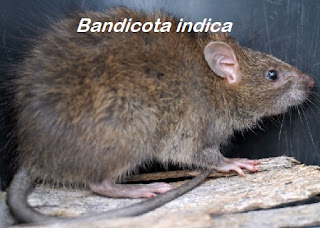This species is a very large rat with HB length 200- 350 mm, T 180-290 mm, and dark brown with relatively large scales. HF 40-60 mm, blackish with long whitish claws. Weight (Wt) 350–600 g. Upperparts blackish-brown with long black guard hairs. Underparts dark brownish grey, giving a shaggy appearance. Mammary tits 12. Distribution and status: In Malaysia, this rat was first recorded as pests in rice fields of Kedah and Perlis in 1946. In Southeast Asian countries it is found in Myanmar, Thailand, Vietnam, Loas, Cambodia, Indonesia (Java, Sumatra) and the Philippines. The species was introduced to Southeast Asia from East Asia. Ecology and Habitat: Nocturnal, terrestrial and omnivorous. The natural diet is plant material, insects, earthworms, mollusks and crustaceans. Some individuals have been found with remnants of skeletons, probably tiny lizards, and scales of fish. It builds extensive burrows, leaving piles of earth mounds on the surface. Sometimes, the burrow is occupied by several pairs of adults and young together. Nests have also been found in termite moulds. It has a habit of a hoarder, storing young rice plants and other food materials inside its burrows. It lives near human activity and swims well.
(4) THE LESSER BANDICOOT (Bandicota bengalensis)
This is a medium sized rat with HB 150-210 mm, T 110-160 mm uniformly brownish, HF 34–38 mm brownish, Weight 200-350 g. Upperparts of body brown intermixed with long dark guard hairs, giving a shaggy appearance. Underparts grayish-white to brownish. The mammary tits vary from 12-20 and arranged in a continuous row down each side of the body, and not always the same number on each side. The description of this rat is based on specimens collected in Pulau Penang. Distribution and status: In Malaysia, the lesser bandicoot rat is found in Pulau Penang. It is also present in Myanmar, Thailand and Indonesia. The species was introduced into the Southeast Asian countries from East Asia. Ecology and habitat are as Nocturnal, terrestrial and omnivorous. In Pulau Pinang this rat is associated with human surroundings and is found as an outdoor resident in towns and villages. It is a scavenger like the Norway rat (Rattus novegicus) wherever food is available. It builds an extensive burrow system like the greater bandicoot rat, sometimes with large families living together and it often stores food. It lives outdoors probably because of competition with the common house rat (Rattus rattus diardii) in which it dominates indoors.
(5) THE RICEFIELD MOUSE (Mus caroli)
This species is a tiny mouse with HB 60-85 mm, HF 15-19 mm, Tail length 60-95 mm with body weight 8-15 g. Hairs short and smooth. The tail is bicolored, dark gray above and whitish below. Upperparts of body brownish gray with the underparts whitish. Feet dark gray to whitish. In size and structure, it is similar to the house mouse (Mus musculus), but differs by coloration. Mammary tits 10. Distribution and status found in Malaysia and it is an introduced species found in rice fields in Kedah. Among the Southeast Asian countries, the species is known in Myanmar, Vietnam, Laos, Cambodia, Thailand and Indonesia. The species is common in East Asia. Ecology and habitat: Nocturnal and terrestrial. It inhabits rice fields and grasslands adjacent to rice fields. It digs small holes in mud banks for nests. Its diet is mainly planting material but also includes insects. This article devided in three segments namely Part 1, Part 2 and Part 3 respectively. Thanks...
Posted from:
Hotel Impiana, Senai,
Johor Bahru, Johor.





No comments:
Post a Comment